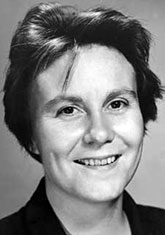Harper Lee
THE AUTHOR

Born
1926
Died
2015
Publications
Novels
Writing languages
English
Literature
• To Kill a Mockingbird (1960)
Novels
• To Kill a Mockingbird (1960)
American Literature
• To Kill a Mockingbird (1960)
Then and now, there and here
Many a great writer is remembered for a single great book among his or her works. But it's rare for a writer to produce just one work in a lifetime and have that one book turn out to be a masterpiece. Emily Brontë comes to mind, but Wuthering Heights was her last novel only because she died at age thirty.
Harper Lee published To Kill a Mockingbird in her mid-thirties and then never completed another novel for the remainder of her nine decades. She is thought to have worked on several more books of fiction and nonfiction but given them up in early stages. She contributed extensively to the research for In Cold Blood, the acclaimed and best-selling book by her friend Truman Capote (who incidentally is a character in To Kill a Mockingbird). But apart from a few essays and the odd letter, all we have to judge Lee's quality as a writer is her single novel.
(Go Set a Watchman, her supposed second novel that came out the year before she died, doesn't count, as it is really an early draft of To Kill a Mockingbird.)
So there is little more to say about Harper Lee's career than has already been said about that one great novel. We can only speculate on how her writing would have developed if she'd kept at it.
One tantalizing comment from Lee in a 1964 interview is that she aspired to be "the Jane Austen of South Alabama".
The remark is intriguing because it immediately brings to mind some otherwise unsuspected parallels between these two very different writers from different times and different places.
Preternaturally mature
In Austen's novels and in Lee's To Kill a Mockingbird the social and familial life of a small community outside the major urban centres is explored both kindly and satirically. The political, artistic and religious issues of the day gripping the world seem far away.
In each authors' works we get a young female perspective—usually that of a perceptive, compassionate observer whose forthright character engages her in the fray. (Yes, Mockingbird's Scout is only a child but rises to preternaturally mature levels in her observations and behaviour.) The main character's point of view develops throughout, as she learns lessons in how we judge, love and get along with each other.
In all these novels, gender roles are gently examined. The disruptive effects of wealth disparity are touched upon—albeit in Austen's work only among the affluent and very affluent. But ultimately both authors wish to preserve social order and support the status quo. Whatever changes they would like to see are in the interpersonal sphere. People should be honest with each other. They shouldn't pre-judge. They should try to understand each other's point of view. They should act out of love.
When it's brought to our attention, it's easy to see the similarities. Harper Lee's writing, however, is much harder edged. Jane Austen never wrote about murder, assault or lynch mobs in her life among the landed gentry. She makes only the slightest allusion to racial issues (namely, in Mansfield Park). The poor who make up the majority of people at the time are seldom seen in her novels. Lee draws a much more realistic picture of her society. Of course, in Scout and Atticus Finch she has characters who can show us the underbelly of their relatively privileged world, while Austen's comfortable young ladies are restricted in what they—and we—can see through their eyes.
Interestingly, pieces we know Lee was working on after To Kill a Mockingbird included depictions of killers. Not exactly Austen territory.
But it wasn't any specific subject matter or such themes Lee was referring to when she made the "Jane Austen of South Alabama" remark.
She was talking about the rich social life in the small towns of the Deep South where she grew up. She wanted to show this passing society in all its complex interactions—with both fondness and a sharp eye—as Austen had shown her own, though limited, social circles. Looking closely into these small worlds of people, their benevolences and their prejudices can tell us something universal about people everywhere. That's the thinking, anyway.
I'm not sure it always works out like that. People have a capacity to compartmentalize—to brush off such revelations as belonging to certain periods and environs that are no longer relevant to our lives.
But it does work to some extent. Most great literature that affects us is rooted in some local scene, though not necessarily as restricted as that of Austen or Lee. Charles Dickens had his London, Leo Tolstoy worked among the Russian aristocracy, Victor Hugo took Paris apart, F. Scott Fitzgerald had his Jazz Age and Ernest Hemingway his Lost Generation.
Millions of people continue to read Austen and Lee not because they have a socio-historical interest in the times and places depicted but because they can relate to those long-past people and situations. And some of it leaks through our attempts to compartmentalize and can still affect our thoughts and behaviours today.
— Eric
THE AUTHOR


